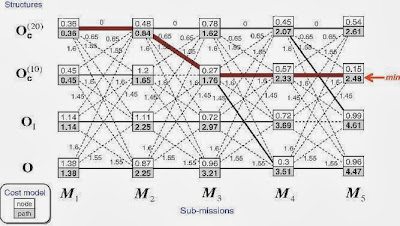According to the state diagram shown in this link finite state machine, a trellis diagram looks like in the following figure can be built. Each node corresponds to a district state at a given time, and each branch represents a transition to some new states at the next instant of time. The trellis begins and ends at the known state x0 and xk. Its most important property is that to every possible state sequence x there corresponds to a unique path through the trellis, and vice versa.
Given a sequence of observations z, every path may be assigned a length proportional to | -ln P(x, z)|, where x is the state sequence associated with that path. This is used to solve the problem of finding the state sequence for which P(x | z) is maximum, or equivalently for which P(x, z) = P(x | z) P(z) is maximum, by finding the path whose length |-ln P(x, z)| is minimum, since ln P(x, z) is a monotonic function of P(x, z) and there is a one-to-one correspondence between paths and sequences (Forney 1973). P(x, z) factor is given as:
Hence, assume if each branch (transition) the length:
Then the total length of the path corresponding to some x is as claimed.
Then the total length of the path corresponding to some x is as claimed.
 is a segment consists of the states to time k of the state sequence x ≈ (x0, x1, ..., xk) and corresponds to a path segment in the trellis starting at the node x0 and terminating at xk.
is a segment consists of the states to time k of the state sequence x ≈ (x0, x1, ..., xk) and corresponds to a path segment in the trellis starting at the node x0 and terminating at xk. For any particular time-k at node xk, there will in general be several such path segments, each with some lengths.
For any time k > 0, there are M survivors in all, one for each xk.
The observation is: the shortest completes path must begin with one of the survivors
Thus at any time-k, we need to remember only M survivor and their lengths
To get to time k+1, we need only to extend all time-k survivors by one time unit, compute the lengths of the extended path segments, and for each node xk+1 select the shortest extended path segment terminating in xk+1 as the corresponding time-(xk+1) survivor. Recursion proceeds indefinitely without the number of survivors ever exceeding M.
References:
- Forney, G. D. 1973. The Viterbi algorithm. Proceeding of the IEEE 61: 268-278.








